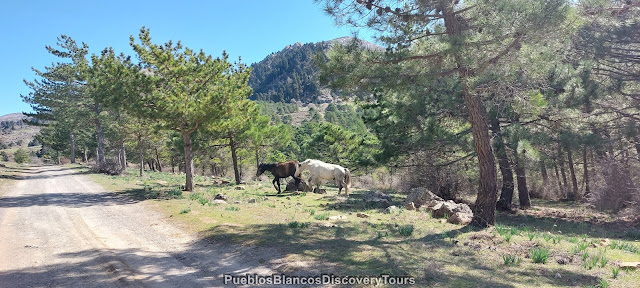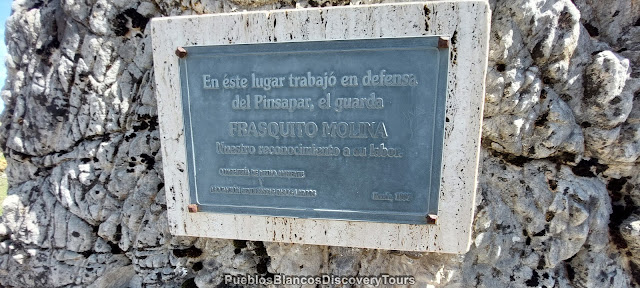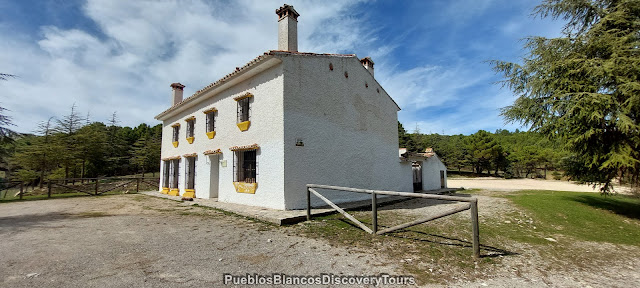A Walk through fields of wild Daffodils
"Quejigales - Torrecilla"
Sierra de las Nieves National Park is located in the western part of the Málaga Province, bounded to the south by the western Costa del Sol, to the east by the Guadalhorce Valley, to the west by the town of Ronda and the Genal valley, and to the north the area of Guadalteba.
The park covers an area of 20.163 hectares. The most striking features of the Sierra de las Nieves are the brilliant white and quite bare looking limestone mountains. The highest peak is the mount Torrecilla (1919m).
Sierra de las Nieves has been long known for its biodiversity and uniqueness.
The emblematic Spanish fir El Pinsapar (Abies pinsapo)is a botanical relic from the ice age, and a large forest can still be found in this area, since the discovery in 1837 by the Swiss botanist Edmond Boissier, who raised the awareness and interest of protection for this mountainous region.
Finally in July 2021 the Sierra de las Nieves was declared a National Park (Parque Nacional de las Sierra de las Nieves)
The Spanish fir, El Pinsapar (Abies pinsapo) is a species of fir found in southern Spain and northern Morocco. Related to other species of Mediterranean firs, it is considered the Andalusian National Tree, and is native to the Andalusian mountains. It appears in the Sierra de las Nieves by Ronda , and Sierra Bermeja in the province of Málaga, and Sierra de Grazalema in the province of Cádiz at altitudes of 900 - 1,800 m.
The Pinsapo can reach a height of 20 - 30 meters. They have to withstand very harsh conditions, very cold winters as this area is very often covered in snow, and very hot dry summers. They are able to pick up the moisture from the air with their short dense needles.
The Hike was a comfortable approx. 5 km walk along a forest road on a high plateau between 1285 m to 1391 m. The Quejigales recreational are can be enjoyed by the whole family.
Note in wintertime the road might be closed due to snow and icy condition.
Map of the hike
 |
| Click on link: Wikiloc: Parauta, Los Quejigales, Sierra de las Nieves |
Directions:
- Coming on the A7 from Marbella take the exit at San Pedro de Alcantara onto A-397 towards Ronda.
- After approx. 35 km/40 minutes take the exit on the right towards the Area Recreativa Quejigales, Sierra de las Nieves National Park
- It is roughly 10 km/20min drive uphill on a well maintained gravel road.
- Total journey from San Pedro de Alcantara is a approx. 45 km/60 minutes.
Area Recreativa de Quejigales is approx. 10 km from main road A-397.
We drive upwards on a well maintained gravel road. Ahead of us the limestone mountains.
In view the Torrecilla massif 1919 m surrounded by a Spanish fir forest.
A majestic Pinsapo tree stands tall at the roadside.
We have reached our destination Quejigales,
this is as far as we are allowed to drive by car.
A large carpark, a recreational area with picnic tables awaits you here.
The "Cortijo de los Quejigales" has a long history. In former times at this location, there always was some kind of dwelling which offered refuge for shepherds and other land workers. As this public area grew of ecological value and the land needed more protection, in the 1950s a house was constructed to host forest guards and firemen. Ever since the building has undergone various renovations in the need to accommodate study groups of biologist, scientists and later on mountaineers and naturalists and cave explorers.
Currently some more reforms are underway to make the refugio more open to the public.
 |
| Rural accommodation Cortijo los Quejigales |
The hike to the peak of Torrecilla (1919m) from the recreation area of "Quejigales" is classed es difficult due to the steep rocky terrain. Estimated time from here, is 3h30min for 7,2 km one way. The trail starts on the other side of the footbridge.
This adventure we left today for another time.
These Daffodils (Narcissus bujei) are an endemic plant to Andalucia.
The yellow flower of about 25 cm can been seen from February to April.
They grow in an altitude of 700 m - 1500 m and prefer calcareous soils.
Apparently, some of the wild horses which roam these mountains.
Soon, these beautiful creatures disappeared back into the the forest.

At the crossroad we took the left turn.
On this route we saw some very very old and beautiful trees!
A pleasure to behold.
Having reached a gate which stopped us on our track, we turned around and walked back.
All around us in the fields were blooming daffodils.
As far as the eye can see, untamed nature.
Amongst the daffodils.
Some of these old trees still have some life in them yet!
Back at the crossroads we turned left and followed the road up hill.
A view towards the north.
At a height of approx. 1391 meters above sea level, we come across a monument.
This monument is dedicated to Frasquito Molina in honor for his work to take care of the Pinsapar trees.
Standing at a height of approx. 1390 meters gives you a sense of proportion.
A Pristine forest of Pinsapos
There they are !
The tree tops are full of resting Griffon vultures (Buitre Leonardo).
Quite amazing to see so many of these large birds in one place.
We wonder how old this tree must be?
A view north.
Looking out onto a vast area of limestone landscape with very sparce vegetation.
A view back towards the road we came on.
High above us towards the right, the Torrecilla massif.
This tree has a peculiar plant growing on its branches.
An unusual parasitic growth (1 m in diameter), high in the branches in one of the pine trees, commonly known as dwarf mistletoe.
Giant pine cones!
Refugio de los Quejigales
Water reservoir kept in case of need to combat wild fires.
We took another look across this unique location before we head back.
Some inquisitive onlooking goats as we drive by.
You come across Hawthorn bushes everywhere.
Map of the hike
 |
| Click on link: Wikiloc: Parauta, Los Quejigales, Sierra de las Nieves |
How to get to Quejigales Sierra de las Nieves National Park





































































No comments:
Post a Comment